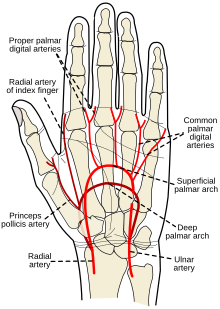Allen test
With the Allen test (after the American doctor Edgar Van Nuys Allen ) the palm arch ( arcus palmaris ), the arteria radialis and the arteria ulnaris can be tested for circulatory disorders. The Allen test is performed before an arterial puncture to ensure blood flow to the hand even if the punctured artery is blocked. Furthermore, the Allen test serves as a clinical examination method prior to a planned removal of a radial flap in order to detect a possible one-sided arterial supply, ie a blood supply only through the arteria radialis or arteria ulnaris, of the hand. However, its diagnostic value is controversial. More precise is an arterial flow determination of the two arteries by means of sonography .
Depending on the question - circulatory disorder of an artery or one-sided blood supply to the palm arch - the test is carried out according to the following scheme:
- Circulatory disorder of an artery : Both arteries are squeezed, the blood in the hand is pumped out of the hand by opening and closing the hand several times and then the occlusion of the artery to be tested is released. Typically, under normal conditions, the hand should refill with blood within a few seconds. If this is not the case, there are circulatory disorders in the artery tested, mostly arteriosclerosis .
- Unilateral blood supply to the palm of the hand : This is where a feeding artery is pressed and the blood supply to the hand is observed. The hand must not become white, which would otherwise indicate an insufficient blood supply through the uncompressed artery. Anatomical features of the blood supply (e.g. the absence of anastomoses in both supply areas) or circulatory disorders are possible causes .
Original description
- EV Allen: Thromboangiitis obliterans: methods of diagnosis of chronic occlusive arterial lesions distal to the wrist with illustrative cases. In: Am J Med Sci. 2, 1929, pp. 1-8.
literature
- Michael Heck, Michael Fresenius: Compendium anesthesiology. 5th edition. Springer, 2007, ISBN 978-3-540-46575-1 .
- D. Henne-Bruns, M. Dürig, B. Kremer: Dual series - surgery. 3. Edition. Thieme, 2008, ISBN 978-3-13-125293-7 .
- DG Cable, CJ Mullany, HV Schaff: The Allen test. In: Ann Thorac Surg . 67 (3), Mar 1999, pp. 876-877. PMID 10215262
